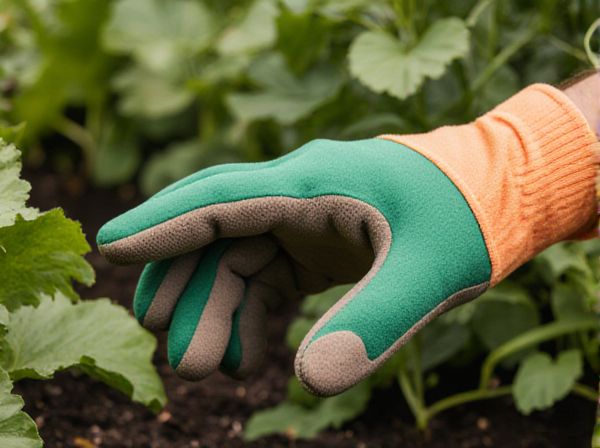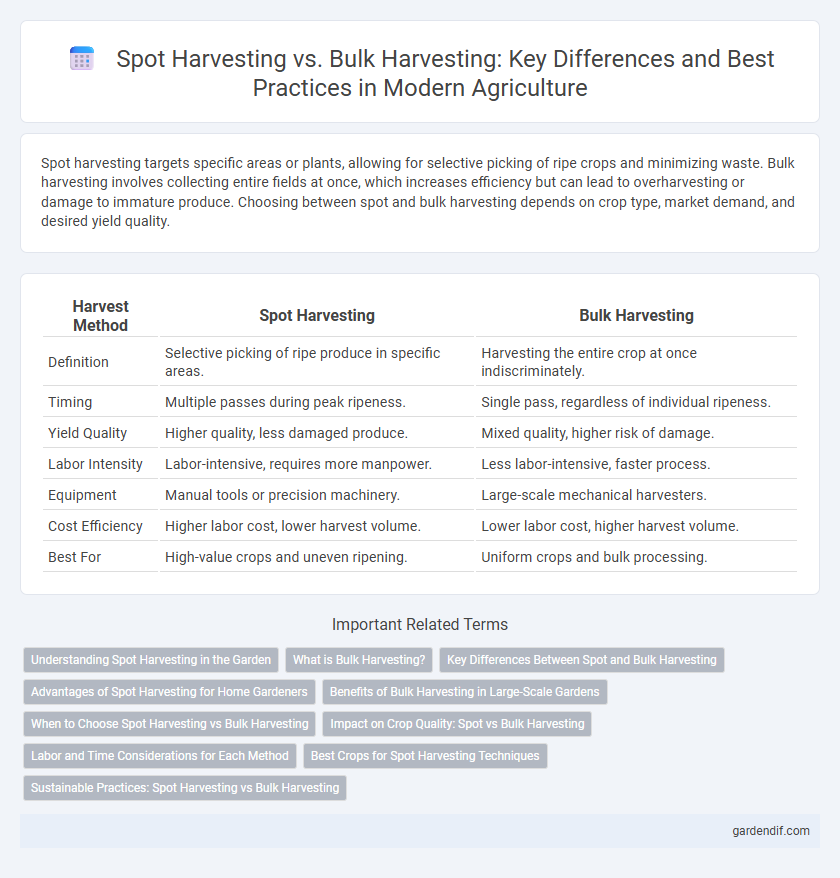
Spot Harvesting vs Bulk Harvesting Illustration
Spot harvesting targets specific areas or plants, allowing for selective picking of ripe crops and minimizing waste. Bulk harvesting involves collecting entire fields at once, which increases efficiency but can lead to overharvesting or damage to immature produce. Choosing between spot and bulk harvesting depends on crop type, market demand, and desired yield quality.
Table of Comparison
| Harvest Method | Spot Harvesting | Bulk Harvesting |
|---|---|---|
| Definition | Selective picking of ripe produce in specific areas. | Harvesting the entire crop at once indiscriminately. |
| Timing | Multiple passes during peak ripeness. | Single pass, regardless of individual ripeness. |
| Yield Quality | Higher quality, less damaged produce. | Mixed quality, higher risk of damage. |
| Labor Intensity | Labor-intensive, requires more manpower. | Less labor-intensive, faster process. |
| Equipment | Manual tools or precision machinery. | Large-scale mechanical harvesters. |
| Cost Efficiency | Higher labor cost, lower harvest volume. | Lower labor cost, higher harvest volume. |
| Best For | High-value crops and uneven ripening. | Uniform crops and bulk processing. |
Understanding Spot Harvesting in the Garden
Spot harvesting targets only ripe fruits or vegetables, maximizing quality and reducing waste by allowing unripe produce to continue maturing. This method enables gardeners to monitor specific plant areas closely, ensuring precise timing for harvesting and better crop management. Compared to bulk harvesting, spot harvesting supports extended harvest periods and enhances overall garden productivity.
What is Bulk Harvesting?
Bulk harvesting involves collecting crops or produce from a large area all at once, often using machinery to expedite the process. This method maximizes efficiency and reduces labor costs, making it ideal for crops like wheat, corn, or soybeans that mature uniformly. Bulk harvesting can increase yield consistency but may result in higher waste if the crop has uneven ripening or quality variations.
Key Differences Between Spot and Bulk Harvesting
Spot harvesting targets specific areas or individual plants, allowing precise collection of ripe crops and reducing damage to unripe produce. Bulk harvesting involves gathering large quantities of crops simultaneously, increasing efficiency but risking higher waste and reduced quality control. The choice between spot and bulk harvesting depends on crop type, maturity uniformity, and economic considerations.
Advantages of Spot Harvesting for Home Gardeners
Spot harvesting allows home gardeners to selectively pick ripe fruits and vegetables, promoting continuous plant growth and extended harvest periods. This method minimizes waste by leaving unripe produce to mature, enhancing overall yield quality and flavor. Targeted harvesting also reduces plant damage and pest exposure compared to bulk harvesting, supporting healthier garden ecosystems.
Benefits of Bulk Harvesting in Large-Scale Gardens
Bulk harvesting in large-scale gardens significantly increases efficiency by allowing the collection of vast quantities of produce quickly with mechanized equipment. This method reduces labor costs and time, optimizing resource allocation and maximizing output. Enhanced consistency in crop handling during bulk harvesting preserves product quality and supports scalable distribution channels.
When to Choose Spot Harvesting vs Bulk Harvesting
Spot harvesting is ideal when crops mature unevenly or when selective picking is required to maintain quality, such as in vineyards or berry fields. Bulk harvesting suits uniform crop maturation and large-scale operations, optimizing time and labor efficiency for crops like wheat or corn. Choosing between spot and bulk harvesting depends on crop type, maturity uniformity, quality standards, and scale of the farming operation.
Impact on Crop Quality: Spot vs Bulk Harvesting
Spot harvesting selectively picks ripe fruits or vegetables, preserving overall crop quality by minimizing damage and ensuring only premium produce is collected. Bulk harvesting gathers entire fields at once, often resulting in mixed ripeness and increased bruising, which can reduce freshness and shelf life. The choice between spot and bulk harvesting directly influences post-harvest quality, market value, and consumer satisfaction.
Labor and Time Considerations for Each Method
Spot harvesting requires more labor-intensive efforts as workers selectively pick ripe produce, leading to longer harvesting times but higher quality yield. Bulk harvesting significantly reduces labor costs and accelerates the process by collecting large quantities simultaneously, though it may result in mixed ripeness and potential product damage. Choosing between spot and bulk harvesting hinges on balancing labor availability, time constraints, and quality priorities.
Best Crops for Spot Harvesting Techniques
Spot harvesting excels with high-value, labor-intensive crops such as berries, grapes, and certain vegetables like tomatoes and peppers, where selective picking ensures optimal ripeness and quality. This technique minimizes waste and damage by targeting only mature produce, making it ideal for delicate fruits and specialty crops that require careful handling. Crops with uneven ripening patterns or those destined for fresh markets benefit most from spot harvesting methods.
Sustainable Practices: Spot Harvesting vs Bulk Harvesting
Spot harvesting minimizes environmental impact by selectively gathering ripe crops, reducing waste and preserving biodiversity in farming ecosystems. Bulk harvesting often leads to increased soil compaction and higher energy consumption due to heavy machinery use, which can degrade soil health and contribute to carbon emissions. Sustainable agriculture increasingly favors spot harvesting techniques to promote resource efficiency, enhance crop quality, and support long-term ecological balance.
Spot Harvesting vs Bulk Harvesting Infographic

 gardendif.com
gardendif.com